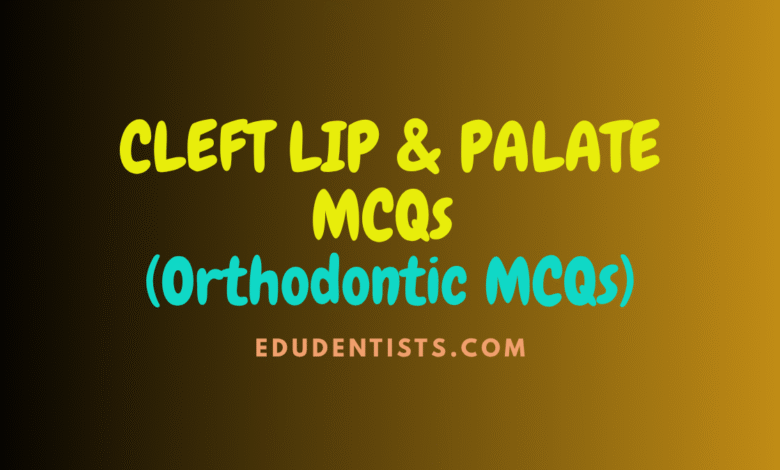
CLEFT LIP AND PALATE MCQs _ Ortho MCQs
CLEFT LIP AND PALATE MCQs _ Ortho MCQs
1. The incidence of cleft palate in India is approximately:
A. 1:500
B. 1:700
C. 1:1,000
D. 1:2,000
2. The incidence of cleft lip and palate in India is approximately:
A. 1:200
B. 1:400
C. 1:600
D. 1:800
3. Cleft palate patients are always evaluated for:
A. Stickler syndrome
B. Seckel syndrome
C. Streiff syndrome
D. Crouzon syndrome
4. In Kernahan striped Y Classification, no. 2 and 5 denotes:
A. Lip
B. Alveolus
C. Hard palate anterior to incisive foramen
D. Hard palate posterior to incisive foramen
5. Millard rule of over 10, in 1967 for cleft lip surgery includes all of the following except:
A. Weight >10 pounds
B. Hemoglobin >10 g%
C. Age >10 weeks
D. Total WBC count 10,000/mm3
6. Rule of 10, recommended by Wilhelmsen and Musgrave (1966) includes all of the following except:
A. 10 pounds weight
B. Total WBC count 10,000/mm3
C. Hemoglobin 10 g%
D. Age >10 weeks
7. Statement A – Unilateral clefts are more common than bilateral clefts
Statement B – Cleft palate is more often associated with bilateral cleft lip than unilateral cleft
A. Both the statements are true
B. Both the statements are false
C. Statement A is true and Statement B is false
D. Statement A is false and Statement B is true
8. The incidence of isolated cleft palate is more in:
A. Males
B. Females
C. Both the gender has equal predilection
D. None
9. In Millard’s classification, No. 3 and 7 represents:
A. Hard palate
B. Soft palate
C. Alveolus
D. Nasal floor
10. American cleft palate association classification (Internationally approved) was established in the year
A. 1962
B. 1931
C. 1958
D. 1987
11. In Veau’s classification, cleft of soft palate only falls under which group/class?
A. Class 1
B. Class 2
C. Class 3
D. Class 4
12. What is the effect of glucocorticoids on palatal growth?
A. It inhibits the growth of palatal mesenchyme
B. It potentiates the growth of palatal mesenchyme
C. Alters the terminal differentiation of medial palatal epithelial cells
D. It has no action of palatal growth
13. Risk of the second child being affected with cleft lip/palate when either one of the parent has cleft palate defect is
A. 5%
B. 10%
C. 25%
D. 30%
14. Secondary alveolar bone grafting for cleft palate is usually done by:
A. 3–5 years of age
B. 9–12 years of age
C. 6–7 years of age
D. 7–10 years of age
15. Conventional orthodontic treatment for cleft palate patients is done by:
A. 10 years of age
B. 15 years of age
C. 18 years of age
D. 3 years after the cleft palate surgery
16. All of the following are features of unoperated cleft subjects except:
A. Tendency for normal maxillary development
B. Smaller sized mandible than noncleft patients
C. Maxilla is placed posteriorly compared to noncleft patients
D. Supernumerary teeth
17. The clefts of the lip and alveolus may have bands of soft tissue bridging across the two sides called
A. Simonart’s bands
B. Bands of Büngner
C. Both of the above
D. None of the above
18. Fusion of palatal shelves begins at:
A. 8th week
B. 9th week
C. 10th week
D. 7th week
19. Primary ABG is usually done between the:
A. First few days of life to 2.5 years age
B. At birth
C. 3–6 years of age
D. 5–8 years of age
20. Early secondary alveolar bone grafting is done between
A. 2 and 5 years old
B. 5 and 7 years old
C. 8 and 10 years old
D. Any time after cleft palate repair
21. Late alveolar bone grafting is done
A. After 13 years of age
B. After 8 years of age
C. After 16 years of age
D. After 10 years of age
22. Cleft lip and palate patient often requires expansion. Appliance of choice in such cases is:
A. Hyrax appliance
B. Hass appliance
C. Cap splint type of expansion appliance
D. SARPE





